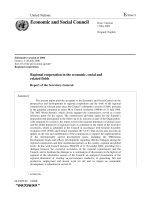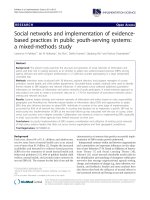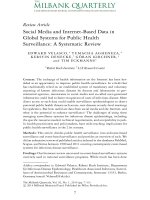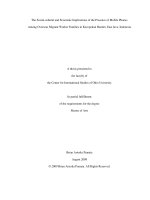Personalizing recommendation in micro blog social networks and e commerce
Bạn đang xem bản rút gọn của tài liệu. Xem và tải ngay bản đầy đủ của tài liệu tại đây (1.53 MB, 127 trang )
Personalizing Recommendation in Micro-blog Social
Networks and E-Commerce
Zhao Gang
Bachelor of Engineering
East China Normal University, China
A THESIS SUBMITTED
FOR THE DEGREE OF DOCTOR OF PHILOSOPHY
SCHOOL OF COMPUTING
NATIONAL UNIVERSITY OF SINGAPORE
2014ACKNOWLEDGEMENTS
First and foremost I would like to thank my supervisors, Professor Mong Li Lee and
Professor Wynne Hsu for their valuable guidance, continuous support, encouragement
and freedom to pursue independent works throughout my Ph.D study. Above all, they
are like my friend, which I appreciate them from my heart.
I would also like to thank my thesis committee, Professor Kian-Lee Tan and Pro-
fessor Min-Yen Kan, who have provided constructive feedback through GRP to this
final thesis. To the many anonymous reviewers at the various conferences, thank you
for helping to shape and guide the direction of my work with your careful and detailed
comments.
I would also like to thank my labmates in the Database Research Lab 2 for their
supports and friendship especially during the many sleepless night rushing to complete
experiments before conference deadline. I will never forget the days we together study-
ing, discussion, playing and eating.
Last but not the least, I would like to thank my parents for their support for past 28
years. Without their encouragement and understanding, it would have been impossible
for me to finish my Ph.D study.
i
ii
TABLE OF CONTENTS
1 Introduction 1
1.1 Background 2
1.2 Motivation 5
1.2.1 User Recommendation in Microblogs . . . . . 5
1.2.2 Product Recommendation in E-commerce . . . 6
1.3 ContributionsofThesis 8
1.4 OrganizationoftheThesis 10
2 Literature Review 11
2.1 RecommendationTechniques 12
2.1.1 Content-based Filtering . . 12
2.1.2 Collaborative Filtering . . 15
2.1.3 Hybrid Recommendations 20
2.1.4 Cluster-based Collaborative Filtering . . . . . 21
2.2 UserRecommenderSystems 22
2.3 Product Recommender Systems . 24
2.4 Summary 25
3 Using Latent Communities for User Recommendation in Microblogs 27
3.1 Motivation 28
3.2 Proposed Framework . . . 30
3.2.1 Discover Communities . . 31
3.2.2 Recommend Followees . . 33
3.3 ExperimentalStudy 36
3.3.1 Experimental Data Sets . . 37
3.3.2 Evaluation Metrics 38
iii
3.3.3 Sensitivity Experiments . . . 39
3.3.4 Comparative Experiments . . 40
3.3.5 Comparison of Community Discovery Methods . . . . . . . . . 41
3.3.6 Scalability Experiments . . . 46
3.4 Summary 49
4 Using Purchase Intervals for Product Recommendation in E-Commerce 51
4.1 Motivation 52
4.2 Preliminaries 54
4.2.1 Utility and Utility Surplus . . 54
4.2.2 Law of Diminishing Returns . 56
4.3 Proposed Framework . 56
4.3.1 Purchase Interval Cube 57
4.3.2 Utility Model with Purchase Intervals 62
4.3.3 Parameter Estimation . 64
4.4 ExperimentalStudy 65
4.4.1 Experiment Dataset . . 66
4.4.2 Evaluation Metrics . . 67
4.4.3 Results and Analysis . 68
4.4.4 Temporal Diversity . . 72
4.4.5 Effect of Taxonomy . . 73
4.5 Summary 75
5 Utilizing Purchase Intervals in Latent Clusters for Product Recommenda-
tion 77
5.1 Motivation 78
5.2 Proposed Approach . . 81
5.2.1 Generate Latent Clusters . . . 81
5.2.2 Refine Latent Clusters 83
5.2.3 Recommend Items . . 85
5.3 Experimentalstudy 87
5.3.1 Experimental Data Set 89
5.3.2 Evaluation Metrics . . 89
5.3.3 Preliminary Experiment . . . 90
5.3.4 Sensitivity Experiments . . . 90
5.3.5 Comparative Experiments . . 93
5.3.6 Analysis of Clustering Methods . . . 93
5.3.7 Analysis of Latent Groups . . 98
5.4 Summary 98
iv
6 Conclusion and Future Work 101
6.1 Conclusion 101
6.2 FutureWork 102
v
vi
SUMMARY
Microblogs and e-commerce have emerged as two important applications of Web 2.0
technology. Service providers rely heavily on personalized recommender systems to
drive sales and s ocial interaction respectively. This thesis seeks to address the challenges
of data sparsity and scalability in recommender systems, and proposes methods to im-
prove the performance of personalized recommendation in microblog social systems and
e-commerce.
We first examine how the Latent Dirichlet Allocation (LDA) to find latent clusters
can be applied to improve user recommendation in microblogs. We utilize the follower-
followee relationship and devise an LDA based method to discover communities among
the users. These communities capture the hidden interests of users as they actively
choose their followees. We apply the state-of-the-art matrix factorization approach on
each community and generate the final top-k recommendation based on the recommen-
dation lists obtained in each community. Extensive experiments on real world Twitter
and Weibo data sets demonstrate that the proposed framework is scalable and effective
in reducing the data sparsity of each community.
Next, we investigate the problem of product recommendation from the perspective
that the value of a product for a user changes over time. We observe that the intervals be-
tween user purchases may influence a users purchase decision, and propose a framework
vii
that utilizes purchase intervals to improve the temporal diversity of the recommenda-
tions. Given the scale of users, products and purchase histories in any e-commerce web-
site, it is necessary to efficiently compute the purchase interval between pairs of product
for all users. We design an algorithm to compute purchase intervals from users’ pur-
chase histories, and incorporate the purchase intervals into a matrix factorization based
method. We demonstrate on a real world e-commerce data set that the proposed ap-
proach improves the conversion rate, precision and recall, as well as achieve a signifi-
cantly higher temporal diversity compared to traditional recommender systems.
Finally, we observe that users may have different preferences when purchasing dif-
ferent subsets of items, and the periods between purchases also vary from one user to
another. We propose a framework that leverages on LDA to generate clusters that capture
users hidden preferences for items as well as item time sensitivity before we apply ma-
trix factorization on each cluster to personalize the recommendations. We introduce the
notion of a cluster purchase interval factor which estimates the probability that users in
a cluster will purchase an item. Experiment results indicate that our approach is scalable
and significantly improves the conversion rate (by up to 10%) of state-of-the art product
recommender methods.
viii
LIST OF TABLES
3.1 Meanings of symbols used 31
3.2 Statistics of Twitter and Weibo data sets . 37
3.3 Performance on Twitter for varying γ and N 40
3.4 Performance on Weibo for varying γ and N 40
4.1 AveragePurchaseIntervals 53
4.2 Effect of ω ontheDensityofPurchaseIntervalMatrix 68
4.3 Sample Products . 71
4.4 SamplePurchaseIntervals(indays) 72
4.5 Sample of User U
10370829
’sPurchaseHistoryinTrainingData 72
5.1 Tensor Decomposition & Clustering Result . . . . . . 79
5.2 CPI Values at t = 24 87
5.3 CPI Values at t = 27 87
5.4 Effect of γ and N on c-PIM F 92
5.5 Sample Latent Groups of Users and Items Purchased . 99
ix
x
LIST OF FIGURES
1-1 Di fferenttypesofrecommendersystems 2
1-2 Generalframeworkofarecommendersystem 4
1-3 S creen shots of followee recommender feature in Twitter and Weibo . . 6
2-1 ExampleofRecommenderSystems 12
3-1 ExampleofaUni-directionalSocialNetwork 28
3-2 MatrixRepresentationoftheNetworkinFigure3-1 29
3-3 GraphicalModelRepresentation 33
3-4 Characteristics of Twitter Dataset . 37
3-5 CharacteristicsofWeiboDataset 38
3-6 Comparative study on Twitter data set . . 42
3-7 ComparativestudyonWeibodataset 43
3-8 NDCG of the various methods . . 44
3-9 S parsity of original dataset vs. discovered communities 45
3-10 Effect of different community discovery methods on conversion rate . . 47
3-11 Effect of LF onruntimeandF1(Weibodataset) 48
4-1 ExampleofUsers’PurchaseHistory 52
4-2 PurchaseIntervalCubeobtainedfromFigure4-1.(Unit:day) 57
4-3 E xample to illustrate Algorithm 1 61
4-4 Characteristics of Jingdong Dataset 67
4-5 E ffect of Window Size ω on PIM F 69
4-6 ComparativeStudy 70
4-7 Top-5 and Top-10 Temporal Diversity for TopPop, MF, UTMF, PIM F 73
4-8 E ffect of Taxonomy 74
xi
5-1 E xample Purchase Interval Matrices for Users (Unit: Day ) . . . . . . . 79
5-2 GraphModelRepresentation 82
5-3 ExampleofUsers’PurchaseHistory 87
5-4 CharacteristicsofDataset 88
5-5 PreliminaryExperimentStudy 91
5-6 E ffect of varying latent factor LF 92
5-7 Comparativeexperiments 94
5-8 Comparison of clustering methods using PIMF . . . 95
5-9 Comparison of clustering methods using MF . 96
5-10 Sparsity of original data set vs. discovered clusters for different cluster-
ing methods . . 97
xii
CHAPTER 1
INTRODUCTION
With the rapid development of Web 2.0 Internet technology, the interaction between
people and Internet has been dramatically changed. Users share their photos online
in Flickr
1
, go to shopping online at Amazon
2
, make new friends online on Facebook
3
,
write their daily updates online in Twitter
4
and watch the latest videos on YouTube
5
,
etc. The increasing online traffic has resulted in huge economic benefits and challenges
for e-service providers, as well as serious information overload for online social network
users. E-service providers are keen to invest in technologies to help users make decisions
and increase satisfaction of users’ online experiences.
Recommender systems have become a core technology to improve user experience
in both e-commerce and social networks. A recommender system [72] aims to provide
suggestions of items to satisfy users’ interest, such as what products to buy, what books
to read, what music to listen to, or what people to connect to.
1
http://www.flickr.com/
2
/
3
/>4
/>5
/>1
1.1 Background
Recommender systems can be broadly classified into three types: (a) editorial recom-
mendations, (b) top-k recommendations, and (c) personalized recommendations. Fig-
ure 1-1 shows examples of these different types of recommender systems employed in
Google Play which recommends Apps to Android OS users. Editorial recommendations
are typically made by experts in some specified areas, while top-k recommender sys-
tems capture statistics from users to determine the most popular item. However, these
two types of recommender systems are not personalized to users. On the other hand,
personalized recommender systems aim to provide users with recommendation based
on their personal preference, and has attracted much attention from researchers in the
information retrieval, data mining, machine learning and database communities.
Figure 1-1: Different types of recommender systems
2
Figure 1-2 gives the general framework of a recommender system. It has the follow-
ing main components:
• Items. Items are the objects that are recommended. Items are characterized by
their value or utility. The value of an item indicates the preference from users. The
main task of recommender systems is to estimate these item values using a range
of properties and features of the items. For example, in a music recommender
system, the genre (such as popular, rop, etc.), as well as the singer, and producer
can be used to describe a song and to learn the utility of an item related to these
features.
• Users. In order to personalize the recommendations, recommender systems ex-
ploit a range of information about the users’ diverse characteristics, including their
feedback or attitude to the items such as ratings, and personal particulars (age,
salary and geographic information, etc.). Such user information is also known
as user profile. Recommender systems utilize user profile to recommend to users
items that are preferred by users who have similar profiles.
• Events. An event is a recorded interaction between a user and an item. An event
typically has the format as < user, item, feedback >, which indicates that a user
gives a feedback on an item. The feedback can be either explicit, e.g., ratings
(1-5 stars) provided in the book recommender system, or implicit e.g, a user has
observed or purchased an item. Another form of user interaction are tags that
users give to items. For instance, in Delicious
1
, users utilize tags or discriminative
words[52] to describe URLs, e.g. ”job hunting”, or ”java development”.
The objective of a recommender system is to determine a ranked lists of items that
are the most suitable products or services for a target user based on the user’s prefer-
ences and constraints learned from user profile. The challenge is to achieve a high user
acceptance rate on their recommendations.
1
/>3
/ƚĞŵƐ
ǀĞŶƚƐĂƚĂďĂƐĞ
hƐĞƌƐ
ZĞĐŽŵŵĞŶĚĂƚŝŽŶŶŐŝŶĞ
ĚǀŝƐŽƌ
ZĞĐŽŵŵĞŶĚĂƚŝŽŶ
>ŝƐƚ
Figure 1-2: General framework of a recommender system
One of the powerful personalization technique is collaborative filtering. This method
increases user acceptance towards recommendation (filtering) on the interests of a user
by collecting preferences or information from many users (collaborating). The system
users, e.g., a consumer in Amazon, provide feedback on their past purchase such as
good, neutral or bad. Recommender systems record these feedback and construct mod-
els to learn what items may be interesting to the users in future. The theory underlying
such recommendation systems is that individuals often rely on recommendations pro-
vided by peers in making decisions [58]. Recommender systems capture this behavior
by leveraging on the recommendations suggested by a community of users to the target
user. The rationale is that if a target user has agreed in the past with some users, then the
other recommendations coming from these similar users should be relevant as well and
are of interest to the target user.
Collaborative filtering techniques have been widely studied in information retrieval
and knowledge management research communities. The current state-of-the-art collab-
orative filtering method is matrix factorization and its variants [47]. However, matrix
factorization involves a computationally intensive learning process, and scalability be-
comes an issue given the huge number of users and items. Further, with limited user
feedback on the wide variety of items, data sparsity continues to be a research challenge.
4
1.2 Motivation
Microblogs and e-commerce have emerged as two important applications of Web 2.0
technology. The service providers rely heavily on personalized recommender systems
to drive social interaction and sales respectively. The goal of this thesis is to develop
efficient and effective methods for (a) user recommendation in microblogs, and (b) prod-
uct recommendation in e-commerce systems. We will discuss their specific research
challenges and briefly describe our proposed approaches to address them.
1.2.1 User Recommendation in Microblogs
One of the most successful Web 2.0 products is the social network platform, e.g. Face-
book and Twitter, which facilitates and enhances relationships among users. The con-
tinued success of these social networks relies heavily on their abilities to recommend
appropriate and relevant users to drive relationship creation.
One typical user recommendation task is for bi-directional friendship social sys-
tems, such as Facebook. The relationships in these systems are reciprocal and model
the friendships in the real world. The most commonly employed user recommendation
technique in bi-directional social systems is compute the number of overlapping friends,
that is, these system will recommend friends who share the most number of friendship
(links) with the target user. This makes sense since they assume that two users know
each other if there is a link between them.
In contrast to the bi-directional relationships in Facebook, the relationships in Twitter-
style social networks or microblogs are uni-directional and not necessarily reciprocal.
The relationships in microblogs are of the follower-followee nature, e.g., the fans follow
some super star, but the super star may not want to build friendship with all his/her fans.
Figure 1-3 shows the screen shots of followee recommendations in Twitter and Weibo.
If the user actually chooses one of the users from the list of recommended top-K users
to follow, then we say that the recommendation is successful.
5
;ĂͿdǁŝƚƚĞƌ ;ĂͿtĞŝďŽ
Figure 1-3: Screen shots of followee recommender feature in Twitter and Weibo
Recommending who to follow in microblogs is a challenge because of the limited
user profile information. Inferring user preferences from their tweets is also difficult as
tweets are inherently noisy. Tweets are typically short (maximum 140 characters) and
they are often peppered with acronyms and abbreviations.
The work in [33] investigates the use of combinations of tweet content and follower-
followee relationships to recommend users to follow in Twitter. They found that follower-
followee relationships are dominant features that capture the interest of users since users
actively choose people they are interested in to follow. In this thesis, we examine how
follower-followee relationships in Twitter-style social network can be utilized to dis-
cover communities and recommend users to follow within these communities. Forming
communities for user recommendation in a uni-directional social network reduces data
sparsity, and is scalable as the matrix factorization of each community (a subset of the
original data set) can be carried out in parallel.
1.2.2 Product Recommendation in E-commerce
A report in [41] reveals that the sales volume of B2C (business-to-Consumer) in China
market is about 47 billion RMB yuan (7.5 billion US dollar) in 2011, and is expected
to reach 650 billion RMB yuan (103 billion US dollar) in 2013. E-service providers are
keen to invest in technologies that help users make purchase decisions and increase the
6
satisfaction of users’ online shopping experiences. E-commerce recommender systems
aim to produce a personalized list of recommendations that users may be interested to
buy. Research [46] has shown that temporal diversity is an important facet of such
systems, and even randomly changing the recommendation list can improve users’ sat-
isfaction with the recommendations [49].
Existing works build models to predict the rating or preference that a user would give
to an item, and items with the highest predicted ratings are then recommended to the user
[82, 30, 76, 57, 59, 65]. However, these models assume that the value of an item for a
user does not change over time, and suffer from the problem of recommending the same
or almost same products to users.
The works in [46, 70, 94] examine the temporal dynamics in recommendation sys-
tems. [70] consider the order of the items purchased and apply the Markov Chain theory
to predict the next item that a user will purchase. [46, 94] design models to capture
changes in user preferences for products over time due to external events such as new
product offerings, seasonal changes or festive holidays (short-term bias) as well as long
term interest. However, the temporal diversity of these works is not high for users who
do not make purchases often and the same top-k item will be repeatedly recommended
to these users.
Theories in economics and consumer behavior postulate that the value of certain
products may change over time, especially if the user has recently purchased them. This
is known as the Law of Diminishing Marginal Utility [8]. For example, a user is less
likely to buy a second computer or mobile phone if s/he has recently bought one. In
contrast, products such as milk, bread and eggs are likely to be purchased over and over
again. Thus the value or marginal utility of a product for a user depends on his/her
purchase history.
Recent works have applied these theories to recommender systems [51, 90]. The
authors in [90] incorporate marginal utility into product recommender systems. They
adapt the widely used Cobb-Douglas utility function [23] to model product-specific di-
7
minishing marginal return and user-specific basic utility to personalize recommendation.
In this thesis, we propose a framework that incorporate purchase intervals for product
recommendation. The model in our framework combines purchase interval information
in users’ purchase histories with marginal utility, and enables us to increase the temporal
diversity of the recommended items.
Besides temporal diversity, studies on consumer behavior have shown that the un-
derlying mechanisms governing user purchase behavior is very complex. A user is often
interested in more than one subset of products, indicating his/her diverse purchase be-
havior. Two users may purchase the same product for different reasons, demonstrating
the diverse characteristics of a product. In this thesis, we also develop a bi-cluster (i.e.,
a clustering method which can both capture user’s preference and item similarity) based
collaborating filtering method, and incorporate temporal information into the recom-
mendation process. Our goal is to find user-item subgroups in the large user-item matrix
that effectively capture the users’ preferences for items as well as item time sensitivity
to increase the conversion rate, i.e., the proportion of users who become buyers.
1.3 Contributions of Thesis
Although many recommender systems have been proposed in the literature and devel-
oped in real world systems to enhance users’ experience in both microblogs and e-
commerce, there still exists limitations as described above. This thesis seeks to address
the challenges of data sparsity and scalability in recommender systems, and proposes
methods to improve the performance of personalized recommendation in microblog so-
cial systems and e-commerce. Specifically, the contributions of this thesis are as follows:
• We examine how the Latent Dirichlet Allocation (LDA) [13] method can be used
to find latent clusters to improve user recommendation in microblogs. We propose
to utilize the follower-followee relationship and devise an LDA based method to
discover communities among the users. These communities capture the hidden
8
interests of users as they actively choose their followees. We apply the state-of-
the-art matrix factorization approach on each community and generate the final
top-k recommendation based on the recommendation lists obtained in each com-
munity. The advantages of the proposed framework are: (a) it learns the different
user preferences from different communities; (b) the data sparsity of each commu-
nity is reduced which improves the recommendation performance; (c) it is scal-
able as the matrix factorization of each community can be performed in parallel.
These advantages are confirmed by extensive experiments on real world Twitter
and Weibo data sets.
• We approach the problem of product recommendation from the perspective that
the value of a product for a user changes over time. We observe that the inter-
vals between user purchases may influence a users purchase decision, and propose
a framework to utilize purchase intervals to improve the temporal diversity of the
recommendations. Given the scale of users, products and purchase histories in any
e-commerce website, it is necessary to efficiently compute the purchase interval
between pairs of product for all users. We design an algorithm to compute the pur-
chase intervals from the users’ purchase histories, and describe how to incorporate
purchase intervals into a matrix factorization based method. We demonstrate on a
real world e-commerce data set that the proposed approach improves the conver-
sion rate, precision and recall, as well as achieve a significantly higher temporal
diversity compared to traditional recommender systems.
• We also observe that users may have different preferences when purchasing differ-
ent subsets of items, and the periods between purchases also vary from one user
to another. We propose a framework that leverages on LDA to generate clusters
that capture the users hidden preferences for items as well as item time sensitivity
before we apply matrix factorization on each cluster to personalize the recom-
mendations. We introduce the notion of a cluster purchase interval factor which
9
estimates the probability that users in a cluster will purchase an item. Experiment
results indicate that our approach is scalable and significantly improves the con-
version rate (by up to 10%) of state-of-the art product recommender methods. We
also compare our approach with a non-LDA method to show that the improvement
is not simply due to the use of purchase intervals.
1.4 Organization of the Thesis
The remainder of this thesis is organized as follows:
• Chapter 2 presents an comprehensive review on existing techniques in recom-
mender systems, with a focus on techniques used in product recommender and
user recommender systems.
• Chapter 3 describes our community-based approach that utilizes follower-followee
relationships to find the hidden interests of users and improve user recommenda-
tion in microblogs.
• Chapter 4 introduces the purchase interval concept in e-commerce systems, and
describes how to utilize the new feature to improve the accuracy and diversity of
recommendation.
• Chapter 5 presents our probabilistic approach to generate latent clusters and use
purchase intervals to refine the clusters to improve the performance of product
recommendation.
• Finally, Chapter 6 concludes the thesis and discusses possible directions for further
research.
10
CHAPTER 2
LITERATURE REVIEW
The manner in which people interact with Internet has changed significantly in the last
two decades. The first revolutionary change are search engines such as Google and
Baidu. However, search engines are passive as they retrieve items in response to users’
queries, while recommender systems are proactive in pushing items that users are in-
terested in. Research in personalized recommender systems emerged in the mid-1990s
[35, 81], and they have become a core technology for e-service providers. Amazon is
one of the pioneers in using recommendations to drive sales; 25% of their annual sales
come from suggesting products to users by showing related books or personalized music
recommendations. Figure 2-1 shows sample screen shots of the variety of recommender
systems.
Recommender systems play an important role in social networks to help connect peo-
ple online and promote social interactions. Similarly, recommender systems not only
help identify what products to offer to an individual customer, but they also help to
increase cross-sell by suggesting additional products to the customers and improve the
consumer loyalty because consumers tend to return to the sites that best serve their needs
[79, 19]. In this chapter, we will first review the state-of-the-art recommender tech-
11









